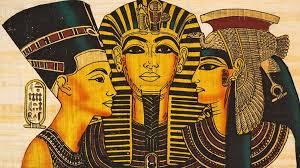A Man of the House of Levi Married a Levite Woman
2: 1-10
A man of the house of Levi Married a Levite woman DIG: Why did Moses’ parents give him up for adoption? What does that say about them? What was the importance of Moses’ mother being able to nurse him until he was five? Where did Moses get his name?
REFLECT: How has race, riches, or your faith shaped you for God’s purposes? Where in your life are you looking for circumstances to favor you? Could you trust the Lord with your child?
Ahmose died and was succeeded by his son, Amenhotep I, who was later honored for founding the institution responsible for building the royal tombs, although he himself was not buried in the Valley of the Kings. He was the second Pharoah of the Eighteenth Dynasty. After his death, Thutmose I became the third Pharaoh of the Eighteenth Dynasty.
Now a man of the house of Levi married a Levite woman (2:1). The names of Moses’ parents are not given here but in 6:20 we learn that his father was Amram and his mother was Jochebed, Amram’s aunt. This Levite couple had two older children: Aaron (6:20) and Miriam (15:20).16 It was significant that Moses was born a Levite. He descended from the Kohathite division of the Levites (see the commentary on the Life of David, to see link click Et – The Kothathites). This group was specially set apart at Mount Sinai to carry the holy objects of the Tabernacle upon their shoulders when the Israelites marched in the desert, especially the ark of the Covenant (Numbers 7:9). Thus, his genealogy was very special to the Hebrew reader; it pointed to the fact that Moses was being set apart for God’s special service, just as his tribe would later be set apart.17 Today the Muslims teach that Moses was not a Jew because he descended from the house of Levi rather than the house of Judah, but we know that all 12 tribes from Jacob make up the Jewish nation.
And Jochebed became pregnant and gave birth to a son. When she saw that he was a beautiful and healthy child, she then hid him for three months because of the decree given by Thutmose I (2:2). She recognized that he was going to be no ordinary child and that God had a special future for him (Acts 7:20), but after three months she couldn’t hide him any longer, so she tried something different.

But when Jochebed could not hide him any longer, she and her husband defied Pharaoh’s decree and hid the baby (Acts 7:17-20). She got a papyrus basket for him and coated it with tar and pitch (2:3a). The Hebrew word for basket used here is the same word translated ark in Genesis 6:14. It was coated with tar and pitch just like Noah’s ark was and it was built for floating, just like Noah’s ark. The Hebrew word for pitch is kafar, and translated atonement elsewhere in the Bible. Because all Hebrew boys were supposed to be drowned in the Nile, placing him among the reeds along the bank of the Nile would seem to be a curious thing to do (2:3b). However, it was really an act of faith. The Bible teaches us that by faith Moses’ parents hid him for three months after he was born, because they saw he was no ordinary child, and they were not afraid of the king’s edict (Hebrews 11:23). They had to trust God with their child. More watchful than Miriam’s, His eyes neither sleep nor slumber (Psalm 121:1-8).
God’s protection is clearly seen in His care of the infant, but there is a human element also. Jochebed told Miriam, Moses’ sister, to stand at a distance to see what would happen to him (2:4). This was also an act of faith. Jochebed wanted to make sure that her son was discovered, so she placed him in a location where the royal court bathed frequently.

Pharaoh’s daughter Hatshepsut was about twenty when she went down to the Nile to bathe in a secluded spot. Her attendants were walking along the riverbank with her. There was the ark. She saw the basket among the reeds and sent her slave girl to get it (2:5). The phrase, among the reeds, is the Egyptian word sup, which is used later in the proper name yam sup for the Red Sea in 13:19.
She opened the papyrus basket and saw the baby. He was crying, and she felt sorry for him. God brought together two things that He has made, a baby’s cry and a woman’s heart. Pharaoh’s daughter could not pass this little baby by.18 She said to her attendants: This is one of the Hebrew babies. Then Moses’ sister Miriam asked Pharaoh’s daughter, “Shall I go and get one of the Hebrew women to nurse the baby for you?” Her offer was not out of place because Pharaoh had murdered so many of the Hebrew babies that there were many Hebrew women able to nurse such a child. She answered: Yes, go. And the girl went and got the baby’s mother (2:6-8).
The rabbis teach that the reason Pharaoh’s daughter recognized the baby to be Hebrew was because she had converted to Judaism. They believe the reason she went into the Nile alone was for Jewish purification purposes, a mikveh, not for a normal bath. They take this theory a bit further and say that she had some contact with Jews and especially with Jewish babies. This is also their explanation of why she decided to keep this baby and bring him to the palace and raise him as her own child. By taking this baby, keeping him alive, bringing him into the palace of the great Pharaoh, and raising the boy as her own son, she broke her own father’s edict to kill every Hebrew male child.
Hatshepsut said: Take this baby and nurse him for me, and I will pay you. So Jochebed took her own baby and nursed him (2:9). The royal decree of killing the Hebrew boy was no longer applicable because he had the royal protection of Hatshepsut herself. In the past, Job spoke to Eliphaz about ADONAI, saying: He catches the wise in their craftiness (Job 5:13), and that’s what happened with Moses. Pharaoh’s own scheme to kill the Hebrew boys was not only thwarted, but his enemy was brought into his own household to become a member of his family! So both Noah and Moses underwent watery trials in which they both survive and become deliverers of God’s people.19
When the child grew older, she took him to Pharaoh’s daughter and he became her son. The normal age of weaning a boy in ancient Egypt was five. Our self-image is set by the age of five; therefore, by the time Jochebed took him to Pharaoh’s daughter to become her son, his Jewishness was already part of his personality. He would never forget his roots. It would be the basis of a life changing decision he would make thirty-five years later (2:11-12). Hence, after being weaned for five years he was legally adopted by Hatshepsut, who was probably in her mid-twenties, to be raised as her son in the royal court of Egypt.
She named him the family name of mose or Moses (which means son of), saying: I drew him out of the water (2:10). Therefore, Moses was adopted and given the Egyptian name mose, the typical name of the Eighteenth Dynasty. There was Ahmose (son of Ah), Kamose (son of Ka) and Thutmose (son of Thut). Every name before the word mose was the beginning of an Egyptian deity. That probably meant that originally Moses had a longer name, beginning with the name of an Egyptian deity and ending with mose. But later, when he rejected his upbringing in the culture and religion of Egypt, he probably dropped the first part of his name because he wouldn’t allow himself to be named after an Egyptian god (Heb 11:24-25).
Historians have called Hatshepsut’s story the Thutmose family feud because it reads like a soap opera. Thutmose I had four children by his great royal wife; however, all died in childhood except the little princess Hatshepsut. He also had a son, Thutmose II, by a woman in his harem. Later, when Thutmose I found himself nearing death, he married his daughter Hatshepsut, then about thirty, to her younger half-brother Thutmose II, who became the fourth Pharaoh of the Eighteenth Dynasty. It was the custom for royal brothers and sisters to marry each other to preserve the royal line. She and her sickly husband had two daughters, but just like his father before him, Thutmose II had a son from his harem. Therefore, when Hatshepsut’s husband, Thutmose II, died prematurely, this son of the harem, Thutmose III, officially became Pharaoh of Egypt when he was only nine years old. What a mess!
Once again, to keep the royal line pure, this boy Pharaoh was married to one of Hatshepsut’s daughters. The situation had become unmanageable. Hatshepsut herself, now about thirty-eight, was named to a group of regents to govern Egypt until Thutmose III was old enough to assume the awesome responsibilities of the Pharaoh of Egypt. He was the fifth Pharaoh of the Eighteenth Dynasty.
Theoretically, Hatshepsut should have faded into the background. And indeed, for the next few years that is just what she seemed to do. She must have walked submissively behind the boy-Pharaoh on all state occasions. And she deferred in every way to her daughter, the Queen. But she resented the young Pharaoh, her half-nephew. Her father had been the mighty Thutmose I. Her great grandfather, Ahmose the Liberator, had driven the dreaded Hyksos from Egypt. She believed that the purest royal blood flowed through her veins, whereas the boy Pharaoh, Thutmose III, was virtually a commoner. He was the son of a harem nobody and Hatshepsut’s husband, was himself only half royal. Thutmose III could only claim one-quarter royal blood. She must have believed with all her heart that despite the fact that she was a woman, she alone, by birth and by blood, was entitled to the throne.

Therefore, early in the young king’s rule, Hatshepsut usurped her half-nephew’s position. She must have donned the most sacred of Pharaoh’s official costumes, a ceremonial dress that went back to the predynastic kings of Egypt. Wearing only a short kilt with a lion’s tail hanging to the ground in the back, carrying the royal scepter in one hand and the sacred crook in the other, and with a square-cut false beard attached to her chin, Hatshepsut mounted the throne and proclaimed herself Pharaoh of Egypt and ruled it for the next twenty-one years. She was not only one of the most remarkable women in the history of Egypt, but also one of the most remarkable women in the history of the world. Her temple dedicated to Amun-Re at Dayr al-Bahri is especially impressive. It included her own funeral monuments as well as chapels dedicated to Osiris, Re, Hathor, Anubis and her royal ancestors.
The moment she seized the throne, Hatshepsut must have banished Thutmose III to the vast and gloomy interior of the temple of Amon. There his head would have been shaved and his royal garments exchanged for a simple linen kilt. He was put into training as an apprentice priest, the court saw him no more, and his name was never mentioned in Hatshepsut’s presence again.20
At that time Moses was born, and he was no ordinary child. For three months he was cared for in his father’s house. When he was placed outside, Pharaoh’s daughter took him and after five years of being nursed by his own mother, Moses was brought up as Hatshepsut’s own son. Between verses 10 and 11 there is a time gap of about thirty-five years. These thirty-five years represent the period of Moses’ training when he was educated in all the wisdom of the Egyptians and was powerful in speech and action (Acts 7:22). But during the years of his ouster, Thutmose III never forgot and he never forgave. He just bided his time, and waited for the opportunity to take revenge on Hatshepsut – or anyone associated with her.



Hi David. I am a bit confused pertained to the name of the lady that found Moses. According to Josephus the lady that found and adopted Moses was Thermuthis. Now I know that Hatshepsut, became the fifth Pharaoh in the 18th century, and a powerful leader indeed. What confuses me: was Thermuthis and Hatshepsut the same person, as well as the queen later on?